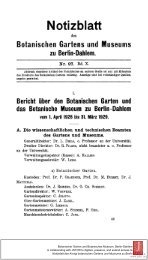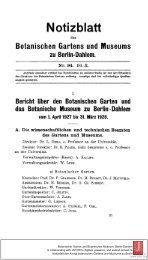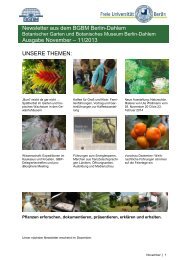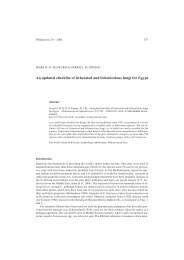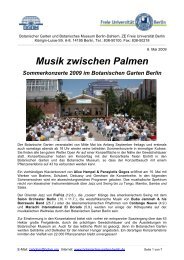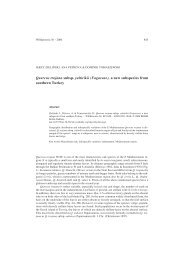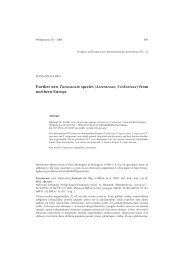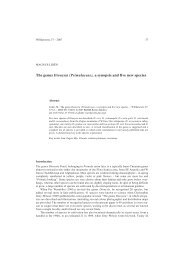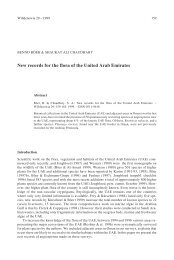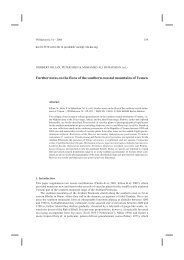Contributions to the flora of the Aegean islands - Botanischer Garten ...
Contributions to the flora of the Aegean islands - Botanischer Garten ...
Contributions to the flora of the Aegean islands - Botanischer Garten ...
Create successful ePaper yourself
Turn your PDF publications into a flip-book with our unique Google optimized e-Paper software.
Willdenowia 32 – 2002 209<br />
BURKHARD BIEL<br />
<strong>Contributions</strong> <strong>to</strong> <strong>the</strong> <strong>flora</strong> <strong>of</strong> <strong>the</strong> <strong>Aegean</strong> <strong>islands</strong> <strong>of</strong> Lesvos and<br />
Limnos, Greece<br />
Abstracts<br />
Biel, B.: <strong>Contributions</strong> <strong>to</strong> <strong>the</strong> <strong>flora</strong> <strong>of</strong> <strong>the</strong> <strong>Aegean</strong> <strong>islands</strong> <strong>of</strong> Lesvos and Limnos, Greece. –<br />
Willdenowia 32: 209-219. 2002. – ISSN 0511-9618.<br />
The floristic results <strong>of</strong> journeys <strong>to</strong> <strong>the</strong> <strong>Aegean</strong> <strong>islands</strong> <strong>of</strong> Lesvos and Limnos over several years are<br />
presented. Retama monosperma is added <strong>to</strong>, and Asphodeline brevicaulis confirmed for <strong>the</strong> <strong>flora</strong><br />
<strong>of</strong> Greece, and 14 new records for Lesvos and 31 for Limnos are given.<br />
Introduction<br />
Some journeys <strong>of</strong> <strong>the</strong> author <strong>to</strong> Greece and <strong>the</strong> <strong>Aegean</strong> between 1985 and 2002, at first particularly<br />
devoted <strong>to</strong> <strong>the</strong> orchid <strong>flora</strong> (Biel 1998a-b, 1999, 2000), have revealed a number <strong>of</strong> additions<br />
and confirmations <strong>to</strong> <strong>the</strong> <strong>flora</strong> <strong>of</strong> <strong>the</strong> country as compared with existing checklists and databases<br />
concerning <strong>the</strong> forthcoming “Flora hellenica” (Strid 1991, Phi<strong>to</strong>s & al. 1997). Specialists for <strong>the</strong><br />
<strong>Aegean</strong> <strong>flora</strong>, who revised herbarium specimens <strong>of</strong> <strong>the</strong> author, encouraged him <strong>to</strong> publish his findings.<br />
Fur<strong>the</strong>r contributions <strong>to</strong> <strong>the</strong> <strong>flora</strong> <strong>of</strong> o<strong>the</strong>r parts <strong>of</strong> Greece are in preparation.<br />
Lesvos. – This E <strong>Aegean</strong> <strong>islands</strong> <strong>of</strong>f Asia Minor is <strong>the</strong> third-largest island <strong>of</strong> Greece (1633 km²,<br />
87 000 inhabitants in 1991). It is markedly structured by two gulfs, which are deeply carved<br />
(about 1/2 <strong>the</strong> width <strong>of</strong> <strong>the</strong> island) in<strong>to</strong> <strong>the</strong> south coast: <strong>the</strong> Gulf <strong>of</strong> Kalloni with c. 21 km and <strong>the</strong><br />
Gulf <strong>of</strong> Gera with 15 km in length. Four mountain massifs dominate <strong>the</strong> island: in <strong>the</strong> north Mt<br />
Lepetimnos (968 m), in <strong>the</strong> east Mt Amali/Kourteri (527 m), in <strong>the</strong> south Mt Olympos (967 m)<br />
and in <strong>the</strong> west Mt Ordymnos/Pr<strong>of</strong>. Ilias (799 m).<br />
Lesvos is located in a transition zone <strong>of</strong> <strong>the</strong> Mediterranean winter rain climate <strong>to</strong> <strong>the</strong> continental<br />
steppe climate <strong>of</strong> Asia Minor. Annual precipitation is relatively high (739 mm; Attika, for<br />
comparison, 400 mm). Dew is <strong>of</strong> importance especially near <strong>the</strong> sea. The maximum temperature<br />
reaches 35° C, <strong>the</strong> minimum c. 0° C (rarely <strong>to</strong> -5° C).<br />
According <strong>to</strong> Launay (1858), Philippson (1901), Jacobshagen (1986) and Hecht (1972), <strong>the</strong><br />
geology <strong>of</strong> Lesvos is extremely heterogeneous. Alternating strata <strong>of</strong> mica-schists, gneiss-granites<br />
and o<strong>the</strong>r siliceous rocks as well as various limes<strong>to</strong>nes and marbles dominate in <strong>the</strong> south-
210 Biel: <strong>Contributions</strong> <strong>to</strong> <strong>the</strong> <strong>flora</strong> <strong>of</strong> Lesvos and Limnos<br />
Fig. 1. Lesvos, drained former alke <strong>of</strong> Megalo Limni, in <strong>the</strong> background Mt Olympos, 967 m. – Pho<strong>to</strong>graph<br />
by B. Biel, 20.4.1995.<br />
east, east and northwest <strong>of</strong> <strong>the</strong> island. Relatively extensive serpentine areas are situated in <strong>the</strong><br />
south and sou<strong>the</strong>ast. Volcanic tuffs and basalt from <strong>the</strong> tertiary occur in <strong>the</strong> west and southwest<br />
<strong>of</strong> <strong>the</strong> island.<br />
The zonal vegetation <strong>of</strong> Lesvos is a Mediterranean evergreen sclerophyllous forest (Horvat<br />
& al. 1974). Actually a Quercus forest (Q. ithaburiensis subsp. macrolepis, Q. pubescens) in <strong>the</strong><br />
west and north and a Pinus forest (P. brutia) between <strong>the</strong> two gulfs, with partial areas in <strong>the</strong> north<br />
and sou<strong>the</strong>ast, cover large coherent areas. Olive groves <strong>of</strong> c. 465 km² (Anonymus 1995) prevail<br />
in <strong>the</strong> eastern half <strong>of</strong> <strong>the</strong> island and west <strong>of</strong> Kalloni, in <strong>the</strong> south locally extending up <strong>to</strong> 650 m. A<br />
Castanea sativa zone is restricted <strong>to</strong> <strong>the</strong> higher altitudes <strong>of</strong> Mt Olympos and Mt Lepetimnos. Degraded<br />
secondary shrub communities, phrygana and macchie, are widely distributed. Arable<br />
fields are confined <strong>to</strong> flat areas near <strong>the</strong> coast and <strong>the</strong> drained ground <strong>of</strong> <strong>the</strong> former inland lake<br />
Megalo Limni (Fig. 1). Almost <strong>the</strong> whole island, including <strong>the</strong> still existing forests, is intensively<br />
grazed by sheep and goats.<br />
A comprehensive account <strong>of</strong> <strong>the</strong> his<strong>to</strong>ry <strong>of</strong> <strong>the</strong> floristic research on Lesvos is given by Bazos &<br />
Yannitsaros (2000), starting with Joseph Pit<strong>to</strong>n de Tournefort, who made a short s<strong>to</strong>p at Mitilini<br />
during his journey <strong>to</strong> Armenia in 1700-02, followed by J. Dumont d’Urville (1822) in 1819, whose<br />
findings have been included by Boissier (1867-84) in <strong>the</strong> “Flora orientalis”; M. de Boissieu (1896)<br />
visited <strong>the</strong> island briefly during a cruise in 1894. The first extensive treatment <strong>of</strong> <strong>the</strong> island’s <strong>flora</strong><br />
was by C. A. Candargy (1889) and P. C. Candargy (1897, 1898, 1899a-b). Unfortunately <strong>the</strong> herbarium<br />
<strong>of</strong> Candargy fa<strong>the</strong>r and son got lost early, thus causing considerable difficulties for later<br />
botanists (see Rechinger 1943: 852). Rechinger (1929, 1943), within <strong>the</strong> scope <strong>of</strong> his work on <strong>the</strong><br />
“Flora aegaea”, visited Lesvos twice (19.-21.5.1927 and 16.-26.5.1934). An important floristic<br />
update was included in <strong>the</strong> “Flora <strong>of</strong> Turkey and <strong>the</strong> East <strong>Aegean</strong> Islands” (Davis 1965-88).<br />
Edmondson (1982) and Nielsen (1989) provided fur<strong>the</strong>r additions <strong>to</strong> <strong>the</strong> <strong>flora</strong> <strong>of</strong> Lesvos and very<br />
recently did so Yannitsaros (1992), Bazos & Yannitsaros (1992, 1994, 1999), Hansen & Nielsen<br />
(1993), Dinter (1995) and Chil<strong>to</strong>n (2002).
Willdenowia 32 – 2002 211<br />
Fig. 2. Limnos, swampy area at Ormos Kondias. – Pho<strong>to</strong>graph by B. Biel, 22.5.1999.<br />
Limnos. – The comparatively isolated N <strong>Aegean</strong> island <strong>of</strong> Limnos (476 km², c. 18 000 inhabitants)<br />
is situated between <strong>the</strong> Chalkidiki peninsula and <strong>the</strong> island <strong>of</strong> Lesvos (distance <strong>to</strong> <strong>the</strong> mainland<br />
100 km northwards and 160 km westwards and c. 65 km SW <strong>of</strong>f <strong>the</strong> Turkish coast near <strong>the</strong><br />
Dardanelles).<br />
The coastline is heavily structured by three extended bays, resulting in a western main part<br />
with two peninsulas <strong>to</strong> <strong>the</strong> south and <strong>to</strong> <strong>the</strong> east. The surface is flat, without marked relief energy.<br />
The few hilly areas, depending on <strong>the</strong> geology and subsequent erosion, are ei<strong>the</strong>r s<strong>of</strong>tly rounded<br />
or forming precipi<strong>to</strong>us cliffs. They only reach altitudes <strong>of</strong> 430 m in <strong>the</strong> northwest and <strong>of</strong> 259 m in<br />
<strong>the</strong> sou<strong>the</strong>ast. Vast coastal marshes occur, in which two brackish lakes are embedded (eastern<br />
peninsula).<br />
Limnos takes an exceptional position concerning wind exposition. The island is situated in <strong>the</strong><br />
prolongation <strong>of</strong> <strong>the</strong> Dardanelles, which considerably gear up <strong>the</strong> etesial (nor<strong>the</strong>asterly) winds, acting<br />
as a narrow wind tunnel (for details, see Rauh 1949). The annual precipitation amounts <strong>to</strong> only<br />
510 mm (i.e. c. 70 % <strong>of</strong> <strong>the</strong> value for <strong>the</strong> neighbouring island <strong>of</strong> Lesvos), with a maximum in December<br />
and January. This small amount <strong>of</strong> rainfall combined with <strong>the</strong> extreme winds results in a<br />
distinctive arid character <strong>of</strong> <strong>the</strong> island’s mesoclimate.<br />
Limnos is chiefly volcanic in origin with roughly 80 % <strong>of</strong> its surface consisting <strong>of</strong> trachytes,<br />
phonolites and volcanic tuffs <strong>of</strong> different character and extent (Launay 1858, Papp 1953, Jakobshagen<br />
1986). Tertiary sediments <strong>of</strong> marly clay and loess loam can be found mainly in <strong>the</strong> lowlands.<br />
Extensive silty, alluvial plains and <strong>the</strong> sandy, salty <strong>to</strong> brackish soils by <strong>the</strong> lakes in <strong>the</strong><br />
hinterland <strong>of</strong> <strong>the</strong> large bays and on <strong>the</strong> eastern peninsula are <strong>of</strong> major importance.<br />
About 30-40 % <strong>of</strong> <strong>the</strong> island’s surface are cultivated, occupied mainly by cereal fields and<br />
vineyards, orchards (partially abandoned) and cattle pastures. The cultivation <strong>of</strong> oat and barley on<br />
arid fields, used for improving cattle food supply during <strong>the</strong> dry summer, is a particular feature <strong>of</strong><br />
Limnos. The remainder <strong>of</strong> <strong>the</strong> island (including swampy areas) is continuously grazed by sheep,<br />
goats, horses and donkeys, making thorny phrygana prevailing from <strong>the</strong> sea shore <strong>to</strong> <strong>the</strong> hill <strong>to</strong>ps
212 Biel: <strong>Contributions</strong> <strong>to</strong> <strong>the</strong> <strong>flora</strong> <strong>of</strong> Lesvos and Limnos<br />
without recognisable altitudinal differences. Sarcopoterium spinosum, Ballota acetabulosa, Euphorbia<br />
characias, Stachys cretica and o<strong>the</strong>rs dominate on dry volcanic substrates, Coridothymus<br />
capitatus covers predominantly marl and loess, <strong>of</strong>ten accompanied by Cistus creticus,<br />
Fumana thymifolia, Helichrysum italicum, Onobrychis arenaria and Teucrium capitatum. Extensive<br />
temporary marshes are found along <strong>the</strong> shallow lakes and bays, with dominating sedges and<br />
rushes (Fig. 2). Woody vegetation on Limnos is represented only by a few small and fragmentary<br />
remnants <strong>of</strong> macchie south <strong>of</strong> Ag. Dimitrios (poor Quercus coccifera stands) and north <strong>of</strong> Kornos<br />
(sparse Spartium junceum heathland), and some oak groves near Kondias and Kondopouli. In addition<br />
<strong>the</strong>re are some small pine afforestations in different places, mostly by settlements.<br />
Little is known about <strong>the</strong> floristic inven<strong>to</strong>ry <strong>of</strong> <strong>the</strong> island and only very little has been published<br />
up <strong>to</strong> now. Even though (according <strong>to</strong> Rechinger 1943) Sibthorp, Tozer (1891) and Butcher<br />
(in Turrill 1922) have collected on Limnos already at an early stage, a basic s<strong>to</strong>ck <strong>of</strong> <strong>the</strong> <strong>flora</strong> was<br />
first recorded by Rechinger (1929) during his stay on 22.-28.5.1927. The publication <strong>of</strong> Rauh<br />
(1949) is an important addition. A few fur<strong>the</strong>r taxa are listed by Economidou (1981).<br />
Material and methods<br />
The island <strong>of</strong> Lesvos was visited by <strong>the</strong> author eight times: 13.-26.5.1993, 31.3.-19.4.1995,<br />
7.-14.6.1995, 15.-31.3.1996, 15.5.-2.6.1996, 1.-8.3.1997, 2.-12.4.1998 and 31.5.-7.6.2000. On<br />
<strong>the</strong>se excursions 494 taxa have been recorded at about 650 sites, 129 herbarium samples and 235<br />
voucher pho<strong>to</strong>graphs have been taken. The island <strong>of</strong> Limnos was visited twice by <strong>the</strong> author, on<br />
15.-24.5.1998 and 16.-23.4.1999; 301 taxa have been recorded at 83 sites, 56 herbarium samples<br />
and 74 voucher pho<strong>to</strong>graphs have been taken. The majority <strong>of</strong> <strong>the</strong> vouchers, especially <strong>of</strong> critical<br />
taxa, has been revised by Arne Strid, Göteborg, and Henry Nielsen, Copenhagen. The voucher<br />
specimens are deposited in <strong>the</strong> herbarium <strong>of</strong> <strong>the</strong> Botanic Garden and Botanical Museum<br />
Berlin-Dahlem (B).<br />
1. New or redeemed records for Greece<br />
Retama monosperma (L.) Boiss. [Syn.: Lygos monosperma (L.) Heywood]<br />
Greece, North <strong>Aegean</strong> Islands, Nomos <strong>of</strong> Lesvos, island <strong>of</strong> Limnos, c. 2.2 km SE <strong>of</strong> Kaminia<br />
(UTM square LE51.82), foot <strong>of</strong> a steep dune slope with phrygana, S <strong>of</strong> a brook valley with wetland,<br />
on sand and s<strong>to</strong>ny marl, 10 m, 21.5.1998, Biel (voucher pho<strong>to</strong>graph, see Fig. 3); ibid., three<br />
individuals partly in full flower, 19.4.1999, Biel BB-LI99.039 (B).<br />
Retama monosperma is a white-flowered broom shrub (Fabaceae), growing up <strong>to</strong> a height <strong>of</strong><br />
3 m, with a W Mediterranean-Atlantic distribution. A quite old shrub is encountered on Limnos,<br />
with c. 10 m in diameter and c. 3 m <strong>of</strong> height, with five main stems each <strong>of</strong> 10-15 cm in diameter,<br />
at <strong>the</strong> foot <strong>of</strong> a steep dune c. 100 m behind <strong>the</strong> coast line. Two younger individuals, c. 1 m <strong>of</strong><br />
height, grow nearby, c. 50 m apart.<br />
The species is accompanied by Ammophila arenaria agg., Anchusa italica, Anthyllis hermanniae,<br />
Calico<strong>to</strong>me villosa, Cnicus benedictus, Euphorbia paralias, Evax pygmaea, Helichrysum<br />
s<strong>to</strong>echas subsp. barrelieri, Lathyrus sphaericus, Lotus cytisoides, Ononis spinosa subsp. antiquorum,<br />
Ophrys sicula, Rumex bucephalophorus subsp. aegaeus, Senecio vulgaris, Sideritis<br />
romana, Teucrium polium subsp. capitatum, Thymus capitatus and Valantia hispida.<br />
Retama monosperma has <strong>to</strong> be qualified as naturalized on Limnos, as <strong>the</strong> habitat is located far<br />
from cultivated areas (closest settlement is Kaminia at a distance <strong>of</strong> c. 2.2 km) and <strong>the</strong> main plant<br />
is very old and has obviously given rise <strong>to</strong> two young individuals, despite occasional grazing.<br />
Asphodeline brevicaulis (Ber<strong>to</strong>l.) Baker<br />
Greece, East <strong>Aegean</strong> Islands, Nomos <strong>of</strong> Lesvos, c. 2 km NNW <strong>of</strong> Agra (UTM square MD 13.77),<br />
on grazed, fallow slope, bordered by a wall <strong>of</strong> natural s<strong>to</strong>nes, with solitary Quercus trees and
Willdenowia 32 – 2002 213<br />
Fig. 3. Retama monosperma (L.) Boiss., old shrub near Kaminia, Limnos. – Pho<strong>to</strong>graph by B. Biel, 21.5.1998.<br />
shrubs <strong>of</strong> Prunus, Rosa and Rubus on soil over porphyr and basalt, 530 m, 20 flowering individuals,<br />
23.5.1996, Biel (voucher pho<strong>to</strong>graph, see Fig. 4); ibid., 10 flowering individuals, 1.6.2000,<br />
Biel BB-LE00.009 (B).<br />
Asphodeline brevicaulis (Ber<strong>to</strong>l.) Baker is an orange-yellow-flowered geophyte, up <strong>to</strong> 70 cm<br />
high. It differs from o<strong>the</strong>r taxa <strong>of</strong> <strong>the</strong> genus in particular by a repeatedly ramified inflorescence.<br />
According <strong>to</strong> Mat<strong>the</strong>ws & Tuzlaci (1984) <strong>the</strong> area <strong>of</strong> distribution, so far known, ranges from W<br />
and S Ana<strong>to</strong>lia over Palestine and Syria as far as N Iraq, or possibly Iran. In Lesvos, <strong>the</strong> species<br />
is accompanied by Allium nigrum, An<strong>the</strong>mis arvensis, Aris<strong>to</strong>lochia hirta, Asparagus acutifolius,<br />
Centaurea cyanus, Conium maculatum, Dracunculus vulgaris, Eryngium campestre, Fritillaria<br />
pontica, Legousia pentagonia, Matricaria recutita, Moenchia mantica, Opopanax hispidus, Orchis<br />
sancta, Paeonia mascula, Papaver rhoeas, Rosa canina agg., Rubus sanctus, Sarcopoterium<br />
spinosum, Urtica dioica and Vicia villosa subsp. eriocarpa.<br />
Within Greece <strong>the</strong> species was exclusively listed by Candargy (1897: 451) for Lesvos: “A.<br />
brevicaulis Bert. – Loco Probatar ad Chydaera”, without fur<strong>the</strong>r data. If “Chydaera” can be iden-
214 Biel: <strong>Contributions</strong> <strong>to</strong> <strong>the</strong> <strong>flora</strong> <strong>of</strong> <strong>the</strong> <strong>Aegean</strong> <strong>islands</strong> <strong>of</strong> Lesvos and Limnos<br />
Fig. 4. Asphodeline brevicaulis (Ber<strong>to</strong>l.) Baker near Agra, Lesvos. – Pho<strong>to</strong>graph by B. Biel, 23.5.1996.<br />
tified with <strong>the</strong> hamlet “Xidhra” (NW <strong>of</strong> Agra), this is most likely <strong>the</strong> same or a neighbouring locality<br />
as given above. Hence <strong>the</strong> occurrence <strong>of</strong> A. brevicaulis in <strong>the</strong> “Flora hellenica” area has<br />
been confirmed after 99 years (herbarium specimens by Candargy do not exist, see Diemar &<br />
Seberg 1989).<br />
2. New and confirmed old records for <strong>the</strong> <strong>flora</strong> <strong>of</strong> Lesvos and Limnos<br />
Acer sempervirens L.<br />
Lesvos: 2.1 km WSW Agiasos, (UTM: MD42.35), 740 m, 6.6.2000, Biel BB-LE00.078 (B). –<br />
Previously mentioned for Lesvos by Yannitsaros & Bazos (1993: 133) and Chil<strong>to</strong>n (2002: 2) but<br />
without specimen citation.<br />
Alisma plantago-aquatica L.<br />
Lesvos: 0.6 km NE Dipi, (UTM: MD52.19), 5 m, 6.6.2000, Biel (obs.).<br />
This observation confirms <strong>the</strong> report by Candargy (1898: 188 as “Alisma Plantago”) in<strong>the</strong><br />
chapter “Plantes plus ou moins communes dans l’ile de Lesbos”.
Willdenowia 32 – 2002 215<br />
Anchusa italica Retz.<br />
Limnos: SE Kaminia, (LE51.82), 10 m, 19.4.1999, Biel (obs.). – Not previously recorded from<br />
Limnos.<br />
Asplenium obovatum Viv.<br />
Limnos: NW Thanos, (LE31.54), 150 m, 22.5.1998, Biel BB-LI98.028 (B). – Not previously recorded<br />
from Limnos.<br />
Centaurium pulchellum (Sw.) Druce<br />
Lesvos: 2.8 km SW Loutropoli Thermis, (MD53.35), 270 m, 2.6.2000, Biel BB-LE00.021 (B). –<br />
Previously only listed for Lesvos by Chil<strong>to</strong>n (2002: 11) but without specimen citation.<br />
Crepis neglecta L. s.l.<br />
Lesvos: 1.5 km NNE Plomari, (MD41.56), 90 m, 5.6.2000, Biel BB-LE00.043 (B). – First record,<br />
<strong>the</strong> population is in all parts more and longer pilose than <strong>the</strong> type, similar <strong>to</strong> C. micrantha<br />
Czerep.<br />
Echinaria capitata (L.) Desf.<br />
Limnos: 1 km ESE Dafni, (LE42.33), 150 m, 20.4.1999, Biel BB-LI99.048 (B). – Not previously<br />
recorded from Limnos.<br />
Euphorbia platyphyllos L.<br />
Lesvos: 1 km ESE Neohori, (MD42.20), 350 m, 9.6.1995, Biel (obs.). – Not previously recorded<br />
from Lesvos.<br />
Euphorbia rigida M. Bieb.<br />
Lesvos: 1.6 km N Plomari, (MD41.46), 270 m, 4.4.1995, Biel (pho<strong>to</strong> no. 9/32); 2.7 km SE Agiasos,<br />
(MD42.74), 470 m, 8.4.1998, Biel (pho<strong>to</strong> no. 27/5); 2.8 km NE Megalohori, (MD42.61),<br />
800 m, 4.6.2000, Biel (obs.). – Listed for Lesvos by Dinter (1995) and Chil<strong>to</strong>n (2002: 10); substantiated<br />
here by <strong>the</strong> cited pho<strong>to</strong>graphs.<br />
Filago pygmaea L.<br />
Limnos: Mirina, S village border above port bay, (LE31.35), 30 m, 17.4.1999, Biel BB-LI99.010<br />
(B). – Not previously recorded from Limnos, up <strong>to</strong> now its nor<strong>the</strong>rnmost occurrence in Greece.<br />
Herniaria cinerea DC.<br />
Limnos: S Mirina, (LE31.35), 30 m, 17.4.1999, Biel BB-LI99.011 (B). – Not previously recorded<br />
from Limnos.<br />
Iris albicans Lange<br />
Lesvos: 2.0 km SW Megalohori, (MD41.37), 380 m, 17.4.1995 & 5.3.1997, Biel (pho<strong>to</strong> no.<br />
12/19). – Several populations on abandoned olive terraces, fully naturalized; not previously recorded.<br />
Lathyrus sphaericus A. J. Retzius<br />
Limnos: SE Kaminia, (LE51.82), 10 m, 19.4.1999, Biel BB-LI99.042 (B). – Not previously recorded<br />
from Limnos.<br />
Lomelosia divaricata (Jacq.) Greuter & Burdet<br />
Limnos: SW Plaka, (LE62.48), 40 m, 23.5.1998, Biel (pho<strong>to</strong> no. 3/36). – Not previously recorded<br />
from Limnos.<br />
Lupinus micranthus Guss.<br />
Limnos: WSW Kondopouli, (LE52.60), 30 m, 23.5.1998, Biel (obs.). – Not previously recorded<br />
from Limnos.<br />
Lysimachia dubia Sol.<br />
Lesvos: 1.9 km NE Dipi, (MD53.20), 15 m, 1.6.2000, Biel BB-LE00.007 (B). – Mentioned for
216 Biel: <strong>Contributions</strong> <strong>to</strong> <strong>the</strong> <strong>flora</strong> <strong>of</strong> <strong>the</strong> <strong>Aegean</strong> <strong>islands</strong> <strong>of</strong> Lesvos and Limnos<br />
Lesvos by Yannitsaros & Bazos (1993: 133) without fur<strong>the</strong>r details, occurrence substantiated<br />
here by <strong>the</strong> cited specimen.<br />
Lythrum borys<strong>the</strong>nicum (Schrank) Litv.<br />
Limnos: SSW Mirina, (LE31.34), 2 m, 16.5.1998, Biel BB-LI98.006 (B). – Not previously recorded<br />
from Limnos.<br />
Malabaila aurea (Sm.) Boiss.<br />
Lesvos: 2.4 km ENE Andissa, (MD14.34), 30 m, 13.6.1995, Biel (obs.). – Not previously recorded<br />
from Lesvos.<br />
Malope malacoides L.<br />
Limnos: SW Plaka, (LE62.48), 40 m, 23.5.1998, Biel BB-LI98.033 (B). – Not previously recorded<br />
from Limnos.<br />
Matthiola sinuata (L.) R. Br.<br />
Limnos: SSW Mirina, (LE31.34), 50 m, 16.5.1998, Biel BB-LI98.035 (B). – Not previously recorded<br />
from Limnos.<br />
Melilotus italicus (L.) Lam.<br />
Limnos: N village border Mirina, (LE31.46), 3 m, 17.5.1998, Biel (pho<strong>to</strong> no. 1/20). – Not previously<br />
recorded from Limnos.<br />
Moenchia mantica (Torn.) Bartl.<br />
Limnos: 3.9 km NE Mirina, (LE31.77), 30 m, 18.5.1998, Biel (obs.); SSE Kaminia, (LE51.72),<br />
40 m, 19.4.1999, Biel (obs.). – Not previously recorded from Limnos.<br />
Muscari commutatum Guss.<br />
Limnos: SSE Kaspakas, (LE32.60), 100 m, 22.4.1999, Biel (obs.). – Not previously recorded<br />
from Limnos.<br />
Muscari weissii Freyn<br />
Lesvos: 1.5 km SSW Megalohori, (MD41.38), 480 m, 16.5.1993, Biel (pho<strong>to</strong> no. 3/11); SE<br />
Agiasos, (MD42.74), 640 m, 10.6.1995, Biel (obs.). – Not previously recorded from Lesvos.<br />
Limnos: 3.9 km NE Mirina, (LE31.77), 30 m, 18.5.1998, Biel (pho<strong>to</strong> no. 1/33); 3.9 km SSE<br />
Kaminia, (LE51.72), 40 m, 19.4.1999, Biel (obs.). – Not previously recorded from Limnos.<br />
Nasturtium <strong>of</strong>ficinale R. Br.<br />
Limnos: S Kondias, (LE40.19), 90 m, 22.5.1998, Biel BB-LI98.030 (B). – Not previously recorded<br />
from Limnos.<br />
Ononis reclinata L.<br />
Limnos: N Sardes, (LE42.06), 100 m, 20.5.1998, Biel BB-LI98.022 (B). – Not previously recorded<br />
from Limnos.<br />
Ononis viscosa subsp. brevi<strong>flora</strong> (DC.) Nyman<br />
Lesvos: 4.8 km SSW Loutropoli Thermis, (MD53.23), 360 m, 2.6.2000, Biel BB-LE00.023 (B);<br />
0.8 km NE Mitilini, (MD62.29), 30 m, 13.5.1993, Biel (obs.); 1.8 km NNE Plomari, (MD41.56),<br />
60 m, 8.6.1995, Biel (obs.). – Listed by Candargy (1898: 192 as “O. brevi<strong>flora</strong>”) in <strong>the</strong> chapter<br />
“Plantes plus ou moins communes dans l’ile de Lesbos”, recently also by Chil<strong>to</strong>n (2002: 13).<br />
These reports are substantiated here by <strong>the</strong> cited specimens.<br />
Parietaria lusitanica L.<br />
Limnos: NW Kaminia, (LE51.55), 100 m, 21.5.1998, Biel (pho<strong>to</strong> no. 3/7). – Not previously recorded<br />
from Limnos.<br />
Paronychia chionaea Boiss.<br />
Lesvos: 2.2 km SW Loutropoli Thermis, (MD53.35), 230 m, 2.6.2000, Biel BB-LE00.018 (B). –<br />
Listed by Candargy (1898: 114) in <strong>the</strong> chapter “Espéces plus ou moins rares et variétés nou-
Willdenowia 32 – 2002 217<br />
velles”, with <strong>the</strong> localities “Olympos 1000-1150 m, Liacas, Petrovouni 200 metr.” – Occurrence<br />
on Lesvos substantiated here by <strong>the</strong> cited specimen.<br />
Petrorhagia dubia (Rafin.) G. López & Romo<br />
Limnos: S Kondias, (LE40.19), 100 m, 22.5.1998, Biel (obs.). – Not previously recorded from<br />
Limnos.<br />
Plantago cretica L.<br />
Limnos: NW Plaka, (LE63.40), 5 m, 23.5.1998, Biel BB-LI98.031 (B). – Not previously recorded<br />
from Limnos.<br />
Polygonum maritimum L.<br />
Limnos: N village border Mirina, (LE31.46), 3 m, 17.5.1998, Biel (obs.). – Not previously recorded<br />
from Limnos.<br />
Pterocephalus plumosus (L.) Coulter<br />
Limnos: S Mirina, (LE31.35), 30 m, 16.5.1998, Biel BB-LI98.003 (B). – Not previously recorded<br />
from Limnos.<br />
Quercus cerris L.<br />
Limnos: Mirina, slope at <strong>the</strong> ascent <strong>to</strong> <strong>the</strong> castle, (LE31.36), 60 m, 16.5.1998, Biel (obs.). – Not<br />
previously recorded from Limnos.<br />
Rosmarinus <strong>of</strong>ficinalis L.<br />
Limnos: 1.3 km NW Livadohori, (LE41.49), 60 m, 21.4.1999, Biel (obs.). – Not previously recorded<br />
from Limnos.<br />
Rosularia serrata (L.) A. Berger<br />
Lesvos: 2.2 km SW Loutropoli Thermis, (MD53.35), 230 m, 2.6.2000, Biel BB-LE00.017 (B). –<br />
Listed by Candargy (1898: 182 under “Umbilicus serratus (L.) DC. – Udj”) in <strong>the</strong> chapter “Espèces<br />
plus ou moins rares et variétés nouvelles”. In case <strong>the</strong> place name “Udja” is identical with<br />
<strong>the</strong> contemporary “Outza”, <strong>the</strong> above cited locality would be situated only c. 7 km northwest, in<br />
rock crevices in a brook ravine with periodically running water. Specimens from cultivated and<br />
probably escaped plants, where cited by Hansen & Nielsen (1993: 150). Without substantiation<br />
by cited specimens <strong>the</strong> species was also listed by Chil<strong>to</strong>n (2002: 8). The above cited record confirms<br />
<strong>the</strong> indigenous status <strong>of</strong> <strong>the</strong> species in Lesvos already claimed by Hansen & Nielsen<br />
(1993: 150).<br />
Rumex crispus L.<br />
Limnos: NE Mirina, (LE31.68), 20 m, 17.5.1998, Biel (obs.). – Not previously recorded from<br />
Limnos.<br />
Scorzonera crocifolia Sibth. & Sm.<br />
Limnos: 3.9 km NE Mirina, (LE31.77), 30 m, 18.4.1999, Biel (pho<strong>to</strong> no. 4/38). – Not previously<br />
recorded from Limnos.<br />
Silene gallica L.<br />
Limnos: 2.0 km NW Kaspakas, (LE32.41), 20 m, 22.4.1999, Biel (obs.). – Not previously recorded<br />
from Limnos.<br />
Stellaria pallida (Dumort) Piré<br />
Limnos: S village border above port bay, Mirina, (LE31.35), 30 m, 17.4.1999, Biel BB-LI99.005<br />
(B). – Not previously recorded from Limnos.<br />
Torilis webbii Jury<br />
Limnos: SW Lihna, (LE51.19), 5 m, 21.5.1998, Biel BB-LI98.024 (B). – Not previously recorded<br />
from Limnos.
218 Biel: <strong>Contributions</strong> <strong>to</strong> <strong>the</strong> <strong>flora</strong> <strong>of</strong> <strong>the</strong> <strong>Aegean</strong> <strong>islands</strong> <strong>of</strong> Lesvos and Limnos<br />
Vitis vinifera subsp. sylvestris (C.C.Gmel.)Hegi<br />
Limnos: WSW Kondopouli, (LE52.60), 30 m, 23.5.1998, Biel (obs.). – Not previously recorded<br />
from Limnos.<br />
Acknowledgements<br />
Particular thanks are due <strong>to</strong> <strong>the</strong> hospitable inhabitants <strong>of</strong> <strong>the</strong> <strong>islands</strong> <strong>of</strong> Lesvos and Limnos, <strong>to</strong><br />
Pr<strong>of</strong>. Arne Strid, Copenhagen/Göteborg, and Dr Thomas Raus, Berlin, for valuable information<br />
<strong>to</strong> <strong>the</strong> <strong>flora</strong> <strong>of</strong> <strong>the</strong> <strong>islands</strong> and literature references, Arne Strid and Henry Nielsen, Copenhagen,<br />
for <strong>the</strong> determination <strong>of</strong> herbarium samples, and J. A. Bazos, A<strong>the</strong>ns, for a joint day <strong>of</strong> excursion<br />
on Lesvos. Special thanks are due <strong>to</strong> Arne Strid for allowing <strong>the</strong> evaluation <strong>of</strong> regional floristic<br />
additions by means <strong>of</strong> <strong>the</strong> “Flora hellenica” database administered in Göteborg.<br />
References<br />
Anonymus 1995: Distribution <strong>of</strong> <strong>the</strong> country’s area by basic categories <strong>of</strong> landuse. – A<strong>the</strong>ns.<br />
Bazos, I. & Yannitsaros, A. 1992: A contribution <strong>to</strong> <strong>the</strong> <strong>flora</strong> and vegetation <strong>of</strong> <strong>the</strong> islets Tokmakia<br />
and Prasologos (Lesvos, Greece). – Proc. 14th Panhell. Biol. Conf., Nicosia-Cyprus:<br />
153-156.<br />
— & — 1994: Floristic investigation <strong>of</strong> some vernal pools <strong>of</strong> Lesvos (East <strong>Aegean</strong>, Greece). –<br />
Proc. 16th Panhell. Biol. Conf., Volos: 27-29.<br />
— & — 1999: Pteridophyte <strong>flora</strong> <strong>of</strong> Lesvos (East Aegaean <strong>islands</strong>, Greece). – Edinburgh J.<br />
Bot. 56: 421-448.<br />
— & — 2000: The his<strong>to</strong>ry <strong>of</strong> botanical investigations in Lesvos island (East <strong>Aegean</strong>, Greece).<br />
– Biologia Gallo-Hellenica, Suppl. Vol. 26: 55-68.<br />
Biel, B. 1998a: Die Orchideen<strong>flora</strong> der Insel Lesvos (Griechenland). – J. Europ. Orchid. 30:<br />
251-443.<br />
— 1998b: Die Orchideen<strong>flora</strong> der Insel Lesvos (Griechenland). Berichtigung zu: Jour. Eur. Orchid.<br />
30(2): 251-443. 1998. – J. Europ. Orchid. 30: 659.<br />
— 1999: Anmerkungen zur Taxonomie im Ophrys scolopax- und Ophrys umbilicata-Komplex<br />
am Beispiel der Insel Lesvos. – Ber. Arbeitskreises Heimischer Orchid. 16 (1): 52-65.<br />
— 2000: Zur Orchideen<strong>flora</strong> der Insel Limnos. – Ber. Arbeitskreises Heimischer Orchid. 17(2):<br />
51-78.<br />
Boissier, E. 1867-84: Flora orientalis 1-5. – Geneva, etc.<br />
Boissieu, M. de 1896: Quelques notes sur la flore d’Orient. – Bull. Soc. Bot. France 43: 283-290.<br />
Candargy, C. A. 1889: Flore de l’ile de Lesbos. Plantes sauvages et cultivées. – Zürich.<br />
Candargy, P. C. 1897: Flore de l’ile de Lesbos. – Bull. Soc. Bot. France 44: 140-162, 369-373,<br />
449-462.<br />
— 1898: Flore de l’ile de Lesbos. – Bull. Soc. Bot. France 45: 108-115, 181-192.<br />
— 1899a: La végétation de l’ile de Lesbos (Mytilène) – 1re Thèse présentée a la faculté des sciences<br />
de Paris. – Lille.<br />
— 1899b: La végétation de l’ile de Lesbos (Mytilène). – Rev. Gén. Bot. 11: 268-280, 310-329,<br />
pl. 12-16.<br />
Chil<strong>to</strong>n, L. 2002: Plant list for Lesvos. – Hunstan<strong>to</strong>n.<br />
Davis, P. H. (ed.) 1965-88: Flora <strong>of</strong> Turkey and <strong>the</strong> East <strong>Aegean</strong> Islands 1-10. – Edinburgh.<br />
Diemar, S. & Seberg, O. 1989: Biographical and bibliographical notes on C. A. and P. C. Candargy.<br />
– Taxon 38: 569-575.<br />
Dinter, I. 1995: Botanische Studienwanderreise. Perlen der Ägäis – die Inseln Lesbos und Chios<br />
in der Ägäis – vom 10.-24. April 1995. – [sine loco].<br />
Dumont D’Urville, J. 1822: Enumeratio plantarum quas in insulis archipelagi aut lit<strong>to</strong>ribus<br />
ponti-euxini, annis 1819 et 1820 collegit atque detexit. – Parisiis.
Willdenowia 32 – 2002 219<br />
Economidou, E. 1981: Le milieu terrestre de l’ile de Limnos et ses reliques de forets. – Biol.-<br />
Ecol. Médit. 8(3-4): 129-138.<br />
Edmondson, J. R. 1982: Additions <strong>to</strong> <strong>the</strong> <strong>flora</strong> <strong>of</strong> Lesvos and its <strong>of</strong>f-shore islets. – Ann. Musei<br />
Goulandris 5: 33-53.<br />
Hansen, A. & Nielsen, H. 1993: Contribution <strong>to</strong> <strong>the</strong> <strong>flora</strong> <strong>of</strong> Lesvos (Mitilini), Greece. –<br />
Willdenowia 23: 143-156.<br />
Hecht, J. 1972: Zur Geologie von Südost-Lesbos (Griechenland). – Z. Deutsch. Geol. Ges. 123:<br />
423-432.<br />
Horvat, I., Glavac, V. & Ellenberg, H. 1974: Die Vegetation Südosteuropas. – Stuttgart & New<br />
York.<br />
Jakobshagen, V. 1986: Geologie von Griechenland. – Stuttgart & Berlin.<br />
Launay, L. de 1858: La géologie des iles de Mételin (Lesbos), Lemnos et Thasos. – Paris.<br />
Mat<strong>the</strong>ws, V. A. & Tuzlaci, E. 1984: Asphodeline Reichb. – Pp. 88-97 in: Davis, P. H. (ed.),<br />
Flora <strong>of</strong> Turkey and <strong>the</strong> East <strong>Aegean</strong> Islands 8. – Edinburgh.<br />
Nielsen, H. 1989: Contribution <strong>to</strong> <strong>the</strong> <strong>flora</strong> <strong>of</strong> Lesbos (Mitilini). – M. Sc. <strong>the</strong>sis, Univ. Copenhagen,<br />
Copenhagen.<br />
Papp, A. 1953: Erläuterungen zur Geologie der Insel Lemnos. – Ann. Géol. Pays Hellen. 5:<br />
1-25.<br />
Philippson, A. 1901: Der Gebirgsbau der Ägäis und seine allgemeinen Beziehungen. – Verh. 7.<br />
Int. Geographenkongr. Berlin 1899. – Berlin.<br />
Phi<strong>to</strong>s, D., Strid, A. & Snogerup, S. (ed.) 1997: Flora hellenica 1. – Koenigstein.<br />
Rauh, W. 1949: Klima<strong>to</strong>logie und Vegetationsverhältnisse der Athos-Halbinsel und der ostägäischen<br />
Inseln Lemnos, Evstratios, Mytilene und Chios. – Sitzungsber. Heidelberger Akad.<br />
Wiss. Math.-Naturwiss. Kl. [o.J.]: 511-615.<br />
Rechinger, K. H. 1929: Beitrag zur Kenntnis der Flora der ägäischen Inseln und Ostgriechenlands.<br />
– Ann. Naturhist. Mus. Wien 43: 269-340.<br />
— 1943: Flora aegaea. Flora der Inseln und Halbinseln des Ägäischen Meeres. – Akad. Wiss.<br />
Wien Math.-Naturwiss. Kl, Denkschr. 105(1).<br />
Strid, A. 1991: The Flora Hellenica Project. – Bot. Chron. 10: 81-94.<br />
Tozer, H. F. 1890: The <strong>islands</strong> <strong>of</strong> <strong>the</strong> <strong>Aegean</strong>. – Reprint 1976, Chicago.<br />
Turrill, W. B. 1922: A contribution <strong>to</strong> <strong>the</strong> <strong>flora</strong> <strong>of</strong> <strong>the</strong> Nearer East. – Bull. Misc. Inform. 1922:<br />
291-298.<br />
Yannitsaros, A. 1992: A contribution <strong>to</strong> <strong>the</strong> adventive <strong>flora</strong> <strong>of</strong> Lesvos (E <strong>Aegean</strong>, Greece). –<br />
Proc. 14th Panhell. Biol. Conf., Nicosia-Cyprus: 157-159.<br />
— & Bazos, I. 1993: The <strong>flora</strong> <strong>of</strong> Lesvos and <strong>the</strong> studies <strong>of</strong> P. C. Candargy. – Proc. 15th Conference<br />
Hellen. Soc. Biol. Sci., Florina-Kas<strong>to</strong>ria: 131-134.<br />
Address <strong>of</strong> <strong>the</strong> author:<br />
Burkhard Biel, Am Judengarten 3, D-97204 Höchberg; e-mail: B_Biel@gmx.de



